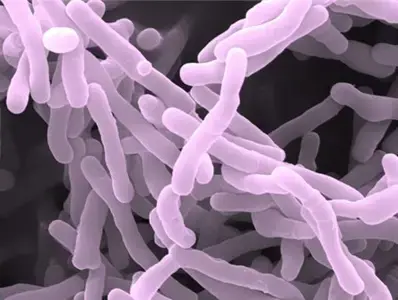Breakthrough Study Identifies Novel Infant Gut Bacteria


In the photo above: Bifidobacterium longum, a beneficial microbe found in the human gut. Image credit: Carine Meyer, Nestlé Research.
Nestlé scientists, in collaboration with internationally recognized researchers from the Broad Institute in U.S., the University of Bologna in Italy, and the icddr,b in Bangladesh discovered a new gut bacteria which is prevalent during the transition from infancy to early childhood.
The discovery, published in the scientific journal Cell, contributes to the understanding of the infant gut microbiome and how it evolves during development. This work enables the identification of the next generation of nutritional solutions and promising probiotics to support children’s growth and development.
The study followed 267 infants in Bangladesh from birth up to two years of age. Most of the mothers chose to exclusively breastfeed their infants for the first 6 months of their lives and then introduced to solid foods in combination with breastmilk during the so-called weaning period. This is a uniquely important period of immune development as it represents the first exposure of the immune system to many new environmental signals from food and bacteria.
The scientists discovered novel strains of Bifidobacterium longum (B. longum), a bacterium typically found in a healthy gut. The novel strains were most prominent as children’s diet diversified, most likely because of their unique ability to utilize both key components of human milk and fibers from solid food.
The new strains are distinct from other beneficial B. longum, including B. longum infantis, which is predominant during early infancy and exclusive breastfeeding. This suggested that the new strains may constitute a novel subspecies. Further research to confirm this is ongoing.
The application of cutting-edge analytical methods provided critical insights on the metabolic activity of novel B. longum and confirmed their link with many other gut microbial species and metabolites, indicating an important role in overall gut ecology and metabolism.
"This discovery opens new possibilities for developing the next-generation of nutritional solutions that can help to maintain or restore a diverse and fully functional gut microbiome in infants”, comments Isabelle Bureau-Franz, Head of Nestlé Research. “This can be obtained either through boosting beneficial gut microbes by feeding them with optimal nutrients or by supplementing with probiotics, especially in populations where the beneficial bacteria are uncommon.
This is especially important for the weaning phase, as no specific solutions exist, and this is a key period is for shaping gut ecosystem and immune health, with potential long-term impact."
The image above depicts abstractly how the newly discovered B. longum plays a role in transitions experienced of food intake during weaning. Weaning is a key period in infant health and development, and this transition between milk and solid foods shapes the infant gut microbiome towards a mature adult state. Image credit: Christophe Barde, Nestlé Research.
References:
- A distinct clade of Bifidobacterium longum in the gut of Bangladeshi children thrives during weaning - ScienceDirect
- Genomic variation and strain-specific functional adaptation in the human gut microbiome during early life | Nature Microbiolog
- Gut microbiome development and childhood undernutrition: Cell Host & Microbe